Social media has transformed the landscape of sports event coverage by offering fans immediate access to information and facilitating direct engagement with teams and athletes. Platforms such as Twitter, Instagram, and Facebook play a crucial role in enhancing the fan experience through real-time updates and interactive content, making them essential tools for sports organizations aiming to build community and foster engagement.
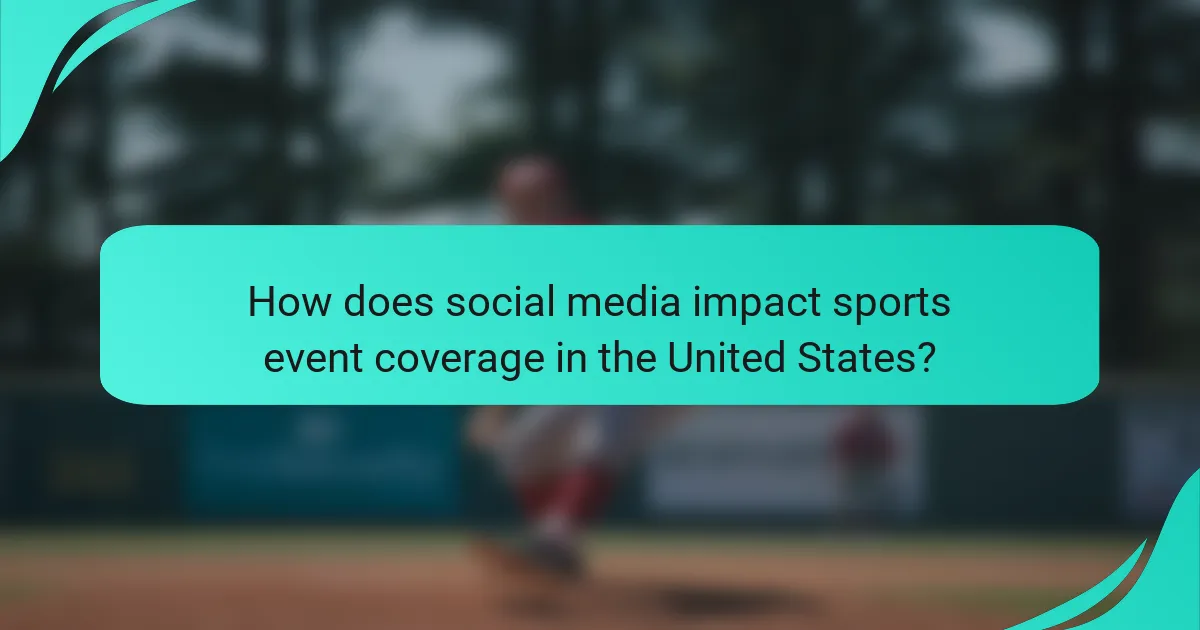
How does social media impact sports event coverage in the United States?
Social media significantly influences sports event coverage in the United States by providing immediate access to information and fostering direct interaction between fans and teams. Platforms like Twitter, Instagram, and Facebook allow for real-time updates, enhancing the overall experience of following sports events.
Increased real-time updates
Social media platforms enable sports organizations to share live updates, scores, and highlights almost instantaneously. This immediacy keeps fans informed and engaged, allowing them to follow events as they unfold, often in real-time. For instance, during major games, teams may post updates every few minutes, ensuring that fans are always in the loop.
Additionally, social media allows for the dissemination of breaking news, such as player injuries or game-changing plays, which can be shared within seconds. This rapid flow of information can significantly shape public perception and fan reactions during events.
Enhanced fan engagement
Social media enhances fan engagement by providing platforms for interaction and community building. Fans can comment on posts, share their thoughts, and participate in discussions, creating a sense of belonging and connection to their favorite teams. This interaction often leads to increased loyalty and support for teams.
Moreover, teams frequently run polls, contests, and Q&A sessions on social media, encouraging fans to participate actively. These initiatives not only boost engagement but also provide valuable feedback to teams about their fan base’s preferences and interests.
Broader audience reach
Social media expands the audience reach for sports events beyond traditional broadcasting methods. With millions of users on platforms like Facebook and Twitter, teams can connect with fans globally, attracting a diverse audience. This broad reach is particularly beneficial for smaller leagues or events that may not receive extensive media coverage.
Furthermore, social media allows for targeted advertising and promotions, enabling teams to reach specific demographics effectively. For example, a local team can promote its games to fans in its city while also engaging with international audiences through strategic content sharing.
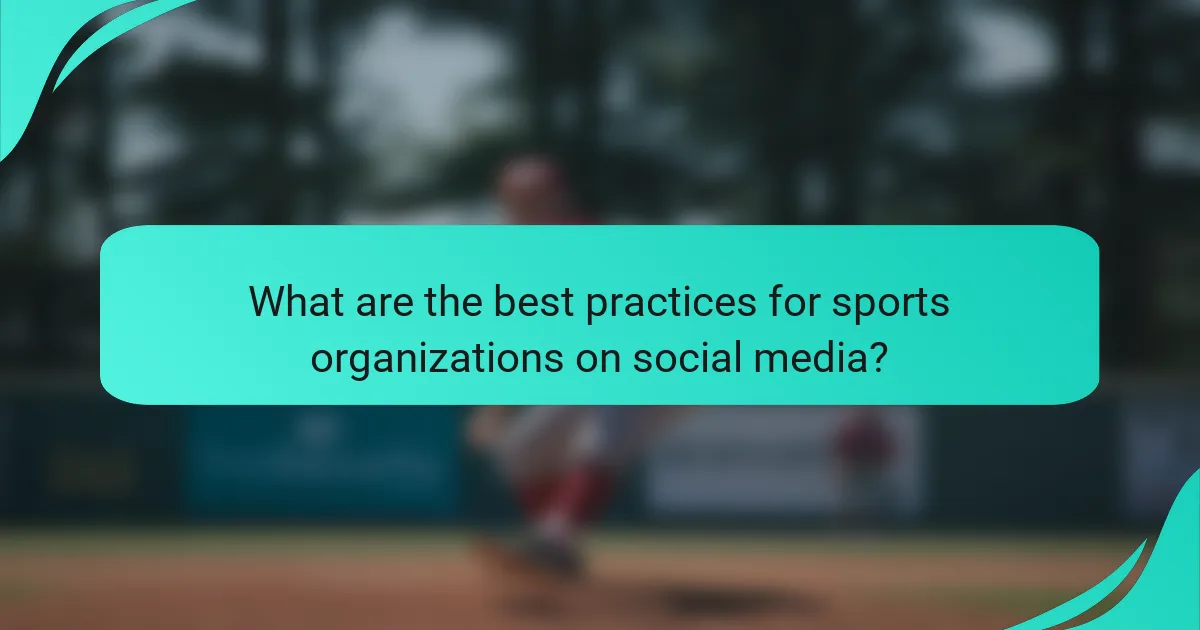
What are the best practices for sports organizations on social media?
Sports organizations can enhance their social media presence by implementing best practices that foster engagement and build community. Key strategies include consistent content scheduling, direct interaction with fans, and the use of multimedia content to capture attention.
Consistent content scheduling
Maintaining a regular posting schedule is crucial for sports organizations to keep fans engaged. Aim to post at least a few times a week, aligning content with key events, such as game days or player announcements. This consistency helps build anticipation and keeps the audience informed.
Utilize social media management tools to plan and automate posts. This approach allows for timely updates and ensures that content is shared during peak engagement times, which can vary based on the platform and audience demographics.
Engaging with fans directly
Direct engagement with fans is essential for building loyalty and community. Respond to comments and messages promptly, and consider hosting Q&A sessions or live chats to foster interaction. This two-way communication makes fans feel valued and more connected to the organization.
Encourage user-generated content by creating hashtags for fans to share their experiences. This not only increases engagement but also provides authentic content that can be shared on the organization’s official channels.
Utilizing multimedia content
Incorporating multimedia content, such as videos, images, and infographics, can significantly enhance engagement. Visual content tends to attract more attention and can convey information more effectively than text alone. For instance, highlight reel videos or behind-the-scenes footage can captivate audiences and encourage shares.
Experiment with different formats, including live streams of events or player interviews, to keep the content fresh and engaging. Analyze which types of multimedia resonate most with your audience and adjust your strategy accordingly to maximize impact.

Which social media platforms are most effective for sports event promotion?
Instagram, Twitter, and Facebook are among the most effective social media platforms for promoting sports events. Each platform serves unique purposes, catering to different aspects of engagement, from visual storytelling to real-time updates and community interaction.
Instagram for visual storytelling
Instagram excels in visual storytelling, making it ideal for showcasing the excitement of sports events through images and videos. High-quality photos, behind-the-scenes content, and engaging stories can capture the attention of fans and create a vibrant narrative around the event.
To maximize impact, use features like Instagram Stories and Reels to share highlights and updates. Aim for a consistent posting schedule leading up to the event, and consider using relevant hashtags to increase visibility.
Twitter for live updates
Twitter is the go-to platform for real-time updates during sports events, allowing fans to follow live scores, player stats, and breaking news. Its fast-paced nature makes it suitable for sharing quick updates and engaging in conversations with fans.
To effectively use Twitter, post frequent updates and engage with followers through polls and questions. Utilize trending hashtags to reach a broader audience, and consider live-tweeting key moments to keep fans informed and engaged.
Facebook for community building
Facebook is effective for community building around sports events, providing a platform for fans to connect, share experiences, and discuss their favorite teams. Creating dedicated event pages can help gather fans and facilitate discussions.
Encourage fan interaction by posting engaging content, such as polls, event reminders, and exclusive behind-the-scenes footage. Consider using Facebook Groups to foster a sense of community and allow fans to share their thoughts and experiences related to the event.
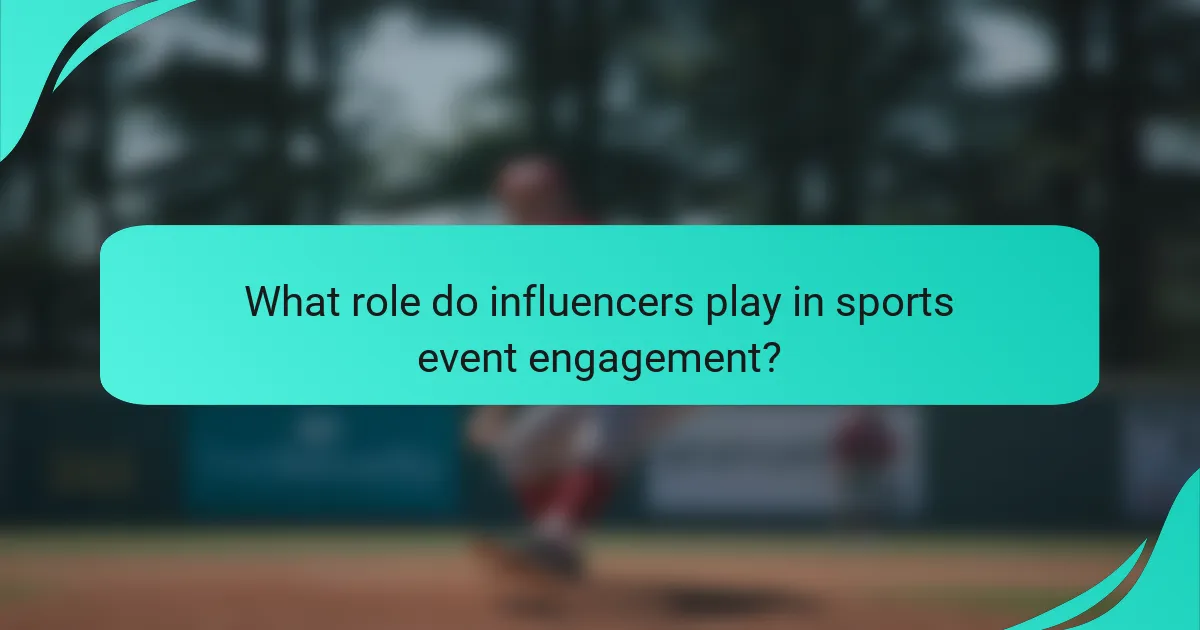
What role do influencers play in sports event engagement?
Influencers significantly enhance sports event engagement by leveraging their reach and credibility to connect with fans. They create buzz around events, promote ticket sales, and foster community interaction, making them vital in modern sports marketing strategies.
Amplifying reach through endorsements
Influencers amplify the reach of sports events by endorsing teams, athletes, or specific matches. Their established follower base allows for messages to spread quickly, often reaching audiences that traditional media might miss. For instance, a popular athlete endorsing a local football match can increase ticket sales by engaging thousands of potential attendees.
Brands often collaborate with influencers to create sponsored content that resonates with fans. This can include social media posts, videos, or live streams showcasing the event. Such endorsements can lead to a significant increase in brand visibility and engagement, often translating into higher attendance and viewership.
Creating authentic connections with fans
Influencers help create authentic connections between sports events and fans by sharing personal experiences and insights. This relatability fosters a sense of community, encouraging fans to engage more deeply with the event. For example, an influencer sharing behind-the-scenes content from a major tournament can make fans feel like they are part of the action.
Moreover, influencers often interact directly with their followers, responding to comments and sharing user-generated content. This two-way communication enhances fan loyalty and encourages more active participation in events, whether through attendance, social media engagement, or merchandise purchases.
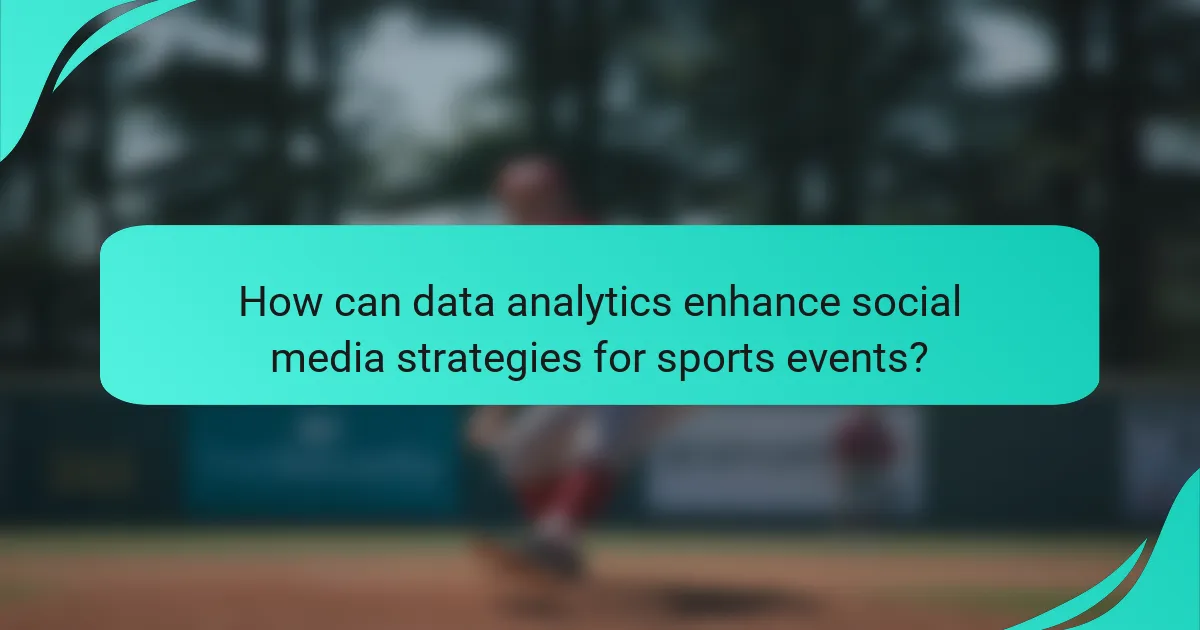
How can data analytics enhance social media strategies for sports events?
Data analytics can significantly improve social media strategies for sports events by providing insights into audience behavior and preferences. By analyzing engagement metrics, teams and organizers can tailor their content to maximize reach and interaction.
Tracking audience engagement metrics
Tracking audience engagement metrics involves monitoring likes, shares, comments, and overall reach on social media platforms. These metrics help identify which types of content resonate most with fans, allowing for more targeted messaging. For instance, a sports team may find that video highlights generate higher engagement than text updates.
Utilizing tools like Google Analytics or social media insights can provide a comprehensive view of audience interactions. Regularly reviewing these metrics can help teams adjust their strategies in real-time, ensuring content remains relevant and engaging.
Optimizing content based on performance
Optimizing content based on performance means refining social media posts to enhance engagement and effectiveness. This can involve A/B testing different types of posts, such as images versus videos, to see which garners more interaction. For example, if polls or questions receive higher engagement, teams should incorporate more of these elements into their strategy.
Additionally, analyzing the timing of posts can reveal optimal times for audience interaction. Posting during peak engagement hours, typically early evenings or weekends, can lead to better visibility and interaction rates. Regularly updating content strategies based on these insights ensures that social media efforts align with audience preferences and maximize engagement.
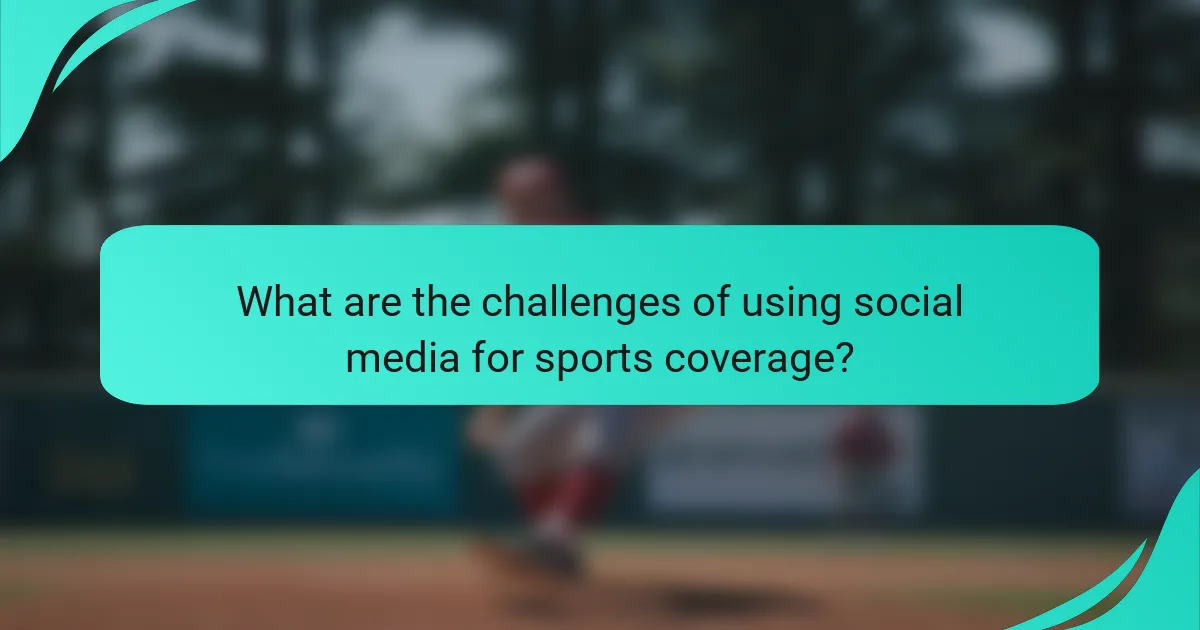
What are the challenges of using social media for sports coverage?
Using social media for sports coverage presents several challenges, including managing negative feedback and ensuring content accuracy. These issues can significantly impact audience engagement and the overall perception of the event.
Managing negative feedback
Negative feedback on social media can quickly escalate, affecting the reputation of sports organizations and athletes. It’s essential to monitor comments and mentions actively to address concerns promptly and professionally.
Organizations should develop a clear strategy for responding to criticism. This includes acknowledging valid points, providing clarifications, and avoiding defensive reactions. Engaging positively with fans can help mitigate backlash and foster a supportive community.
Ensuring content accuracy
Accurate content is crucial in sports coverage, as misinformation can spread rapidly on social media. Journalists and teams must verify facts before posting to maintain credibility and trust with their audience.
Implementing a checklist for content verification can be beneficial. This may include cross-referencing with official sources, checking statistics, and confirming quotes. Regular training on media literacy for staff can also enhance the overall quality of information shared.

How can sports teams leverage user-generated content?
Sports teams can effectively leverage user-generated content (UGC) by encouraging fans to share their experiences and interactions with the team. This not only enhances engagement but also builds a sense of community and loyalty among supporters.
Encouraging fan participation
To foster fan participation, sports teams should create campaigns that invite fans to share their content, such as photos, videos, and stories related to games or events. Utilizing social media platforms like Instagram, Twitter, and TikTok can amplify these efforts, as fans are more likely to engage on platforms they frequently use.
Offering incentives, such as contests or giveaways, can motivate fans to contribute their content. For example, a team could run a photo contest where the best fan photo from a game wins merchandise or tickets to future events. This not only generates UGC but also enhances the overall game-day experience.
It’s crucial to maintain a consistent brand voice while sharing user-generated content. Teams should ensure that the content aligns with their values and image, and always credit the original creators. This practice fosters goodwill and encourages more fans to participate in the future.
